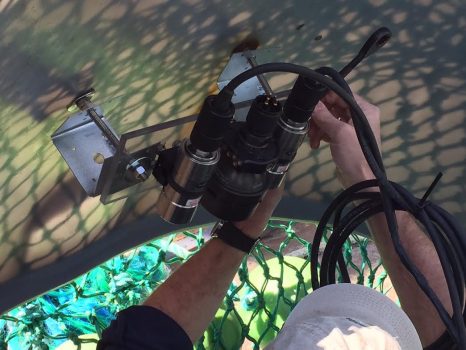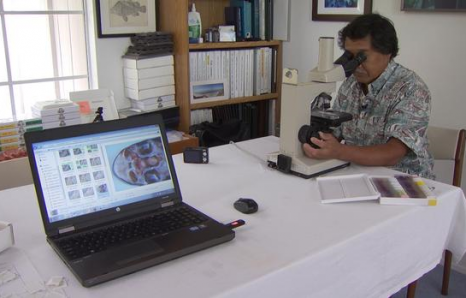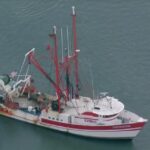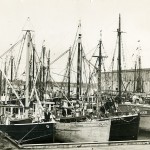Category Archives: Marine Science

Famous 16-Foot Great White Shark Gone Missing
Mary Lee, the 16-foot Great White Shark that has had Twitter in a frenzy the past few weeks, has gone missing – electronically speaking. According to Ocearch, a conservation group set out to track and collect date from tiger and great white sharks, said her transmitter hasn’t had a “ping” since June 17, and no one has seen or heard from her since. Fans on twitter have been speculating her death, but never fear, it is more likely her tracker has lost battery power. click here to read the story 06:15

Deep-water experiment reveals lobsters’ appetite for jellyfish
A team from Heriot-Watt University was surprised to find lobster scaring off other marine life in order to eat defrosted helmet jellyfish carcasses which has been attached to an underwater camera and lowered 250 metres in the Sognefjorden in western Norway. The experiment was designed to find out which deep-water species were most attracted by a jellyfish dinner, with hagfish and amphipods expected to be interested. But it was the Norway lobster – worth around £80 million to Scottish fishing catches – that was most keen and ate half of the jellyfish. click here to read the story 10:15

Salmon or trout: What the heck is a steelhead, anyway?
Until just a few days ago, anyone interested in learning about B.C.’s struggling steelhead might stumble upon a website from Fisheries and Oceans Canada describing them as a type of Pacific salmon. The fish, according to this now-defunct page, “were at one time considered a trout species but have been discovered by biologists to be more closely related to Pacific salmon than other trout.”There’s just one problem with that: The current consensus is that steelhead aren’t salmon, they’re trout.,, A trout that behaves like a salmon click here to read the story 16:42 

Hatchery Fish Often Fail in the Wild. Now We Might Know Why
Wild salmon are struggling to get their groove back.,, For years, Canada has tried to help bolster the salmon population by releasing hatchery-raised juvenile fish, or smolts, into the wild. Scientists know these hatchery smolts don’t do well in the wild—the fish tend to die younger than their wild brethren and reproduce less, but it’s unclear why. In a recent study, however, researchers think they’ve hit upon a possible explanation.,, In Washington State, hatchery-spawned steelhead also do poorly in the wild. click here to read the story 12:31

Study: Ocean noise may hinder fish mating
The party is noisy. The music and conversation drown out what you want to say. Welcome to the world of the cod, haddock and other fishwhere its considerably harder because its done in the dark, 160 feet below the ocean surface, where vital communication – essrtially “Here I am, over here!”- can be lost at the constant roar of ships passing overhead, An increasingly noisy ocean may mean fish are having a hard time finding one another to spawn and navigate, according to a new study by NOAA scientists and published last month in the online journal Scientific Reports by Nature. click here to read the story 10:28

Matt Ridley: Blue Planet II Was Superb, Save A Few Fishy Facts
Nothing that Hollywood sci-fi screenwriters dream up for outer space begins to rival the beauty and ingenuity of life under water right here. Blue Planet II captured behaviour that was new to science as well as surprising: giant trevally fish eating sooty terns on the wing; Galapagos sea lions herding yellowfin tuna ashore; an octopus wrapping itself in shells to confuse sharks. The series also preached. Every episode had a dose of bad news about the ocean and a rebuke to humanity, while the entire last episode was devoted to the environmental cause, featuring overfishing, pollution, climate change and ocean acidification. The team behind the incomparable Sir David Attenborough has acceded to demands that it should push more environmentalism. click here to read the story 12:26

Research shows juvenile endangered California salmon use different rivers than expected
In a paper published online last week in the journal Biological Conservation, a team of California researchers revealed a surprising finding: Juvenile winter-run Chinook aren’t just using the Sacramento River as rearing habitat; after hatching, they also venture in large numbers into the river’s tributaries, including creeks that feed into it below Redding, as well the Feather and the American rivers. Winter-run Chinook are a distinct species of salmon that return each year to spawn and die in the Sacramento River near Redding. click here to read the story 11:16

A close encounter with an albatross
Nahuel Chavez is a seabird biologist who has worked as an Albatross Task Force (ATF) Instructor in Argentina for eight years. He has been passionate about saving albatross since his first trip on a longline-fishing vessel when he saw huge numbers of them being killed, and knew he had to do something to stop it. Nahuel writes to us from a trawler off the coast of Argentina where he is on a 55-day trip to monitor the impact on seabirds. photo’s, click here to read the story 20:46

Net-mounted LED lights help reduce bycatch in Pacific hake fishery
LED lights can help reduce bycatch by aiding the escape of Chinook salmon from Pacific hake trawl nets, according to a study done by researchers at the Pacific States Marine Fisheries Commission and the Northwest Fisheries Science Center. The lights influence where salmon exit bycatch-reducing windows in the hake nets, and could increase the total number of salmon that escape, the researchers say. In a series of tests in 2015, the lights seemed to attract the Chinook salmon. During the tests, 86 percent of the salmon that escaped used the openings framed by LED lights. click here to read the story 15:48

Sam Parisi – Unless we have the science compared to an independent survey we are in peril at NOAA hands
I was reading an article in South Coast Today regarding the new director of NOAA Jon Hare who said quote, he is willing to talk to the fishermen. Among his duties at the Northeast Fishery Science Center, Mr. Hare is responsible for conducting the ground fish surveys that determine annual catch limits for each species. Fishermen have disagreed with NOAA findings and actually taken photo’s of thousand of lbs of cod caught in their nets. Up to now the vessel Bigelow has done NOAA surveys but now is dockside for repairs, and in it’s place is the Pisces that will only conduct a thirty day survey instead of sixty. click here to read the story 15:43

Endangered orcas compete with seals, sea lions for salmon
Harbor seals, sea lions and some fish-eating killer whales have been rebounding along the Northeast Pacific Ocean in recent decades. But that boom has come with a trade-off: They’re devouring more of the salmon prized by a unique but fragile population of endangered orcas. Competition with other marine mammals for the same food may be a bigger problem than fishing, at least in recent years, for southern resident killer whales that spend time in Washington state’s Puget Sound, a new study suggests. click here to read the story 07:43

Juvenile striped bass maintain average abundance in Virginia waters in 2017
Preliminary results from an ongoing long-term survey conducted by researchers at the Virginia Institute of Marine Science suggest an average year class of young-of-year striped bass was produced in Virginia tributaries of Chesapeake Bay in 2017. The 2017 year class represents the group of fish hatched this spring that will grow to fishable sizes in 3 to 4 years. The program, formally known as the Juvenile Striped Bass Seine Survey, recorded a mean value of 8.98 fish per seine haul in the Virginia portion of Chesapeake Bay, which is similar to the historic average of 7.77 fish per seine haul. click here to read the story 08:16

Scientists accused of scaremongering, ‘overheated claims’ with warning to humanity
A recent warning to humanity endorsed by thousands of scientists around the world includes “scaremongering” and “overheated” claims while ignoring much of the progress made in recent decades, some experts say. “It concerns me that the message from science is this doom-and-gloom scenario that just turns off about 75 per cent of people,” said Erle Ellis, an associate professor of geography and environmental systems at the University of Maryland, Baltimore County. “There’s a small percentage that loves the crisis narrative, and they just repeat it over and over to each other.” click here to read the story 10:03

Savannah scientists continue study of black gill in shrimp
As the Research Vessel Savannah moved slowly along Georgia’s coast in early October, Wynn Gale calmly arranged about a dozen shrimp on a table inside one of the boat’s laboratories. He inspected each specimen for dark gill coloration, and then he took a photo of the shrimp on his smartphone. Black gill, named because of a telltale dark coloration on shrimps’ gills, is caused by a microscopic parasite. Scientists have determined that the parasite is a ciliate, a single-cell organism, but have yet to identify the specific type. Scientists say shrimp suffering from black gill are safe for humans to eat. click here to read the story 08:53

Squid: Coming to Life – How a cephalopod is born, in stunning microscopy footage
Produced by the evolutionary and developmental biologist Nipam Patel in his Patel Lab at the University of California, Berkeley, Squid: Coming to Life literally puts squid and cuttlefish development under the microscope. With a sparkling soundtrack and stunning microscopy footage, the short video shows the cephalopods transforming from embryos (when they develop in egg capsules) to hatchlings that emerge with the resplendent, colour-shifting skin they use for communication and camouflage. click here to watch the video 09:35

Über-Fish: The Amazing Tunas
Tunas are part of the family Scombridae, which also includes mackerels, large and small. But there are tunas, and then there are, well, “true tunas.” Two groups (sometimes known as “tribes” dominate the tuna clan. One is Thunnini, which is the group considered true tunas, characterized by two separate dorsal fins and a relatively thick body. The 15 species of Thunnini are albacore, bigeye, black skipjack, blackfin, bluefin (three species: Atlantic, Pacific, southern), bullet, frigate, kawakawa, little tunny, longtail, skipjack, slender and yellowfin. The other tribe is Sardini; these tunas — the dogtooth tuna and several species of smaller true bonitos — are somewhat more mackerel-like (notably with a more elongated body and a row of sharp, conical teeth). photo’s, click here to read the story 18:38
Transatlantic tuna may be boosting stocks in Gulf of St. Lawrence
 New science released by the international body that manages Atlantic bluefin tuna suggests a theory about why there have been so many tuna in the Gulf of St. Lawrence in recent years. Katie Schleit, senior marine campaign coordinator for the Ecology Action Centre, said science released by the International Commission for the Conservation of Tuna (ICCAT) found a large number of the tuna caught in Gulf waters are from the Mediterranean region. click here to read the story 16:33
New science released by the international body that manages Atlantic bluefin tuna suggests a theory about why there have been so many tuna in the Gulf of St. Lawrence in recent years. Katie Schleit, senior marine campaign coordinator for the Ecology Action Centre, said science released by the International Commission for the Conservation of Tuna (ICCAT) found a large number of the tuna caught in Gulf waters are from the Mediterranean region. click here to read the story 16:33
Rarely seen ‘living fossil’ frilled shark caught off Algarve coast
 A frilled shark, a species that is often termed a ‘living fossil’ because of several ‘primitive’ features that have survived for millions of years, has been captured off the coast of Portugal’s Algarve region, the country’s meteorological and sea institute has announced. Researchers from IPMA and the Centre for Maritime Sciences recorded the catching of a shark “with unusual features” by a commercial trawler, as part of an “initiative to minimise undesirable catches in European fisheries”. click here to read the story 22:43
A frilled shark, a species that is often termed a ‘living fossil’ because of several ‘primitive’ features that have survived for millions of years, has been captured off the coast of Portugal’s Algarve region, the country’s meteorological and sea institute has announced. Researchers from IPMA and the Centre for Maritime Sciences recorded the catching of a shark “with unusual features” by a commercial trawler, as part of an “initiative to minimise undesirable catches in European fisheries”. click here to read the story 22:43
Strange fish found on the Scotian Shelf
 For 25 years Don Clark has been going to the Scotian Shelf to see what’s there. For the last decade the fisheries biologist at the St. Andrews Biological Station in New Brunswick has been in charge of the federal Fisheries and Oceans summer survey. Just after Canada Day each year, the CCG Alfred Needler heads out to trawl 240 way points on the Scotian Shelf between Georges Bank in the south and the Laurentian Channel in the north. It’s an immense area — the 120,000 square kilometres of continental shelf that extends off Nova Scotia’s eastern shore into the North Atlantic. click here to read the story 11:56
For 25 years Don Clark has been going to the Scotian Shelf to see what’s there. For the last decade the fisheries biologist at the St. Andrews Biological Station in New Brunswick has been in charge of the federal Fisheries and Oceans summer survey. Just after Canada Day each year, the CCG Alfred Needler heads out to trawl 240 way points on the Scotian Shelf between Georges Bank in the south and the Laurentian Channel in the north. It’s an immense area — the 120,000 square kilometres of continental shelf that extends off Nova Scotia’s eastern shore into the North Atlantic. click here to read the story 11:56
Alligators eat sharks — and a whole lot more
 Alligators don’t just stick to freshwater and the prey they find there. These crafty reptiles can live quite easily, at least for a bit, in salty waters and find plenty to eat — including crabs, sea turtles and even sharks. “They should change the textbooks,” says James Nifong, an ecologist with the Kansas Cooperative Fish and Wildlife Research Unit at Kansas State University in Manhattan, who has spent years documenting the estuarine gator diet. Nifong’s most recent discovery, splashed all over the news last month, is that the American alligator (Alligator mississippiensis) eats at least three species of shark and two species of rays, he and wildlife biologist Russell Lowers report in the September Southeastern Naturalist. click here to read the story 21:46
Alligators don’t just stick to freshwater and the prey they find there. These crafty reptiles can live quite easily, at least for a bit, in salty waters and find plenty to eat — including crabs, sea turtles and even sharks. “They should change the textbooks,” says James Nifong, an ecologist with the Kansas Cooperative Fish and Wildlife Research Unit at Kansas State University in Manhattan, who has spent years documenting the estuarine gator diet. Nifong’s most recent discovery, splashed all over the news last month, is that the American alligator (Alligator mississippiensis) eats at least three species of shark and two species of rays, he and wildlife biologist Russell Lowers report in the September Southeastern Naturalist. click here to read the story 21:46

MPA’s – Conch herds face death by old age as young molluscs disappear
The queen of the sea, a monster mollusk that inspired its own republic in the American state of Florida, is in trouble. A marine preserve in the Bahamas, famed for its abundance of queen conches, is missing something too: young conches. Researchers studying the no-take park (where no collection of marine animals is allowed) off Exuma in the Bahamas, one of hundreds throughout the Caribbean, found that over the last two decades, the number of young has sharply declined as adult conches steadily matured and died off. The discovery also raises questions about the effectiveness of marine preserves, long viewed as a solution to reviving overfished stocks. If one of the Caribbean’s oldest and best marine preserves isn’t working to replenish one of its biggest exports – now regulated as tightly as lobster – what does that mean for other preserves and how they’re managed? click here to read the story 11:33

Global Ocean Cooling in September
We have seen lots of claims about the temperature records for 2016 and 2015 proving dangerous man made warming. At least one senator stated that in a confirmation hearing. Yet HadSST3 data for the last two years show how obvious is the ocean’s governing of global average temperatures. The best context for understanding these two years comes from the world’s sea surface temperatures (SST), for several reasons: click here to read the story 09:55
DFO’s Inaugural Citizen Science Cod Project – creates cod assessment data, community involvement
 Notwithstanding a car that perpetually reeked of fish, Madelyn Swackhamer is singing the praises of her summer job. The 17-year-old from Bareneed, Conception Bay North, was one of 40 high school students hired by the Department of Fisheries and Oceans (DFO) for its inaugural Citizen Science Cod Project.,, The pilot project involved having pairs of students located at 20 landing wharves in communities on the Northeast Avalon, Conception Bay, Trinity Bay, Bonavista Bay and Notre Dame Bay throughout the course of the province’s summer and fall recreational food fisheries. The students were charged with recording data on how many fish are being caught, the length of each fish, and the arrival and departure of participating vessels. click here to read the story 22:06
Notwithstanding a car that perpetually reeked of fish, Madelyn Swackhamer is singing the praises of her summer job. The 17-year-old from Bareneed, Conception Bay North, was one of 40 high school students hired by the Department of Fisheries and Oceans (DFO) for its inaugural Citizen Science Cod Project.,, The pilot project involved having pairs of students located at 20 landing wharves in communities on the Northeast Avalon, Conception Bay, Trinity Bay, Bonavista Bay and Notre Dame Bay throughout the course of the province’s summer and fall recreational food fisheries. The students were charged with recording data on how many fish are being caught, the length of each fish, and the arrival and departure of participating vessels. click here to read the story 22:06

Live Cam May Show True Status of Atlantic Cod Fishery
Atlantic cod, New England’s most iconic fish, has been reported at historic lows for years, but fishermen hope a new video monitoring technique will prove there are more of the fish than federal surveyors believe. Ronnie Borjeson, who has been fishing for more than 40 years, says the federal surveys don’t match up with what fishermen are seeing. “I don’t care if you’re a gillnetter, a hook and line guy, a trawl guy,” he said, “there’s codfish everywhere up there. Everywhere. You can’t get away from them.” Borjeson helped test a video rig designed by researchers at the University of Massachusetts Dartmouth that allows them to record fish underwater and count them on the video later. With this rig, scientists can sample a larger area in the same amount of time and hopefully improve federal estimates of how many cod are left. click here to read the story 16:26
Counting Fish – A film by Don Cuddy click here to watch
Baltic clams and worms release as much greenhouse gas as 20,000 dairy cows
 Scientists have shown that ocean clams and worms are releasing a significant amount of potentially harmful greenhouse gas into the atmosphere. The team, from Cardiff University and Stockholm University, have shown that the ocean critters are producing large amounts of the strongest greenhouse gases – methane and nitrous oxides – from the bacteria in their guts. The researchers estimate that this is equivalent to as much methane given off as 20,000 dairy cows. This is as much as 10 per cent of the entire Welsh dairy cow population and 1 per cent of the entire UK dairy cow population. click here to read the story 16:23
Scientists have shown that ocean clams and worms are releasing a significant amount of potentially harmful greenhouse gas into the atmosphere. The team, from Cardiff University and Stockholm University, have shown that the ocean critters are producing large amounts of the strongest greenhouse gases – methane and nitrous oxides – from the bacteria in their guts. The researchers estimate that this is equivalent to as much methane given off as 20,000 dairy cows. This is as much as 10 per cent of the entire Welsh dairy cow population and 1 per cent of the entire UK dairy cow population. click here to read the story 16:23
The Ocean’s Low-Oxygen Dead Zones Are Getting Worse
 Along the West Coast, low-oxygen levels in bottom layers of the ocean, known as hypoxia, have become a big concern for scientists and fishers alike—fish and crabs are vital to ecosystems, research, and an entire industry. “We’re always on the lookout to see, is this going to be a bad year?” says Francis Chan, a marine ecologist at Oregon State University who studies the effects of ocean chemistry. And by all accounts, 2017 shaped up to be a bad year. Scientists first got reports of crabs dying in pots off the Oregon coast back in 2002. Since then, says Chan, there have been some years when the oxygen levels in some places drop to zero and stay that way for weeks or even months. Video, click here to read the story 17:16
Along the West Coast, low-oxygen levels in bottom layers of the ocean, known as hypoxia, have become a big concern for scientists and fishers alike—fish and crabs are vital to ecosystems, research, and an entire industry. “We’re always on the lookout to see, is this going to be a bad year?” says Francis Chan, a marine ecologist at Oregon State University who studies the effects of ocean chemistry. And by all accounts, 2017 shaped up to be a bad year. Scientists first got reports of crabs dying in pots off the Oregon coast back in 2002. Since then, says Chan, there have been some years when the oxygen levels in some places drop to zero and stay that way for weeks or even months. Video, click here to read the story 17:16
Many fishermen believe Stokesbury saved the scallop industry
 Well, I guess that I had better start writing some of this stuff down, as it seems that my memory is getting fuzzier by the day. Not an uncommon affliction for an old fisherman, who has been put ashore, but who still has enough recall to remember some things that are just too important to allow to fade into obscurity! I had been a scalloper out of New Bedford for 32 years, both as a deckhand, and as a captain of several high-line scalloper vessels. Over all those years there were several trips that stay relatively fresh in my mind’s eye, but one of the most important and fulfilling ones actually occurred after I came ashore. By Jim Kendall click here to read the story 21:55
Well, I guess that I had better start writing some of this stuff down, as it seems that my memory is getting fuzzier by the day. Not an uncommon affliction for an old fisherman, who has been put ashore, but who still has enough recall to remember some things that are just too important to allow to fade into obscurity! I had been a scalloper out of New Bedford for 32 years, both as a deckhand, and as a captain of several high-line scalloper vessels. Over all those years there were several trips that stay relatively fresh in my mind’s eye, but one of the most important and fulfilling ones actually occurred after I came ashore. By Jim Kendall click here to read the story 21:55

Thousands of Sharks, Other Sea Life Mysteriously Die in San Francisco Bay, State Says No Funding Available to Determine Cause
As many as 2,000 leopard sharks have mysteriously died in the San Francisco Bay over the past few months. The California Department of Fish and Wildlife says determining the cause is not a priority for the state since the sharks are not threatened or endangered, however, scientists say additional research and resources are crucial since the threat is now believed to be preying on other marine life. “This pathogen can tackle a variety of different species … we’ve had a much more diverse group of fish that have been found dead in the San Francisco Bay.” At least 500 bat rays, hundreds of striped bass, 50 smooth-hound sharks and about 100 halibut died in the bay between February and July, according to Okihiro’s estimates. Video, click here to read the story 09:24





















































